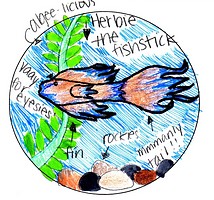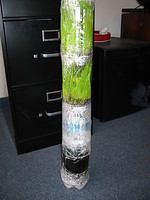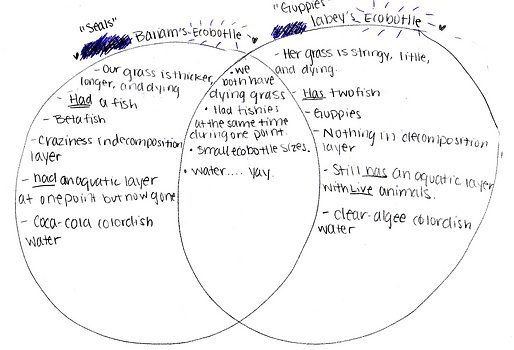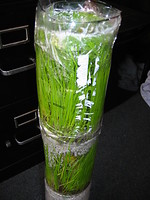Hey Hey Hey! This is the Ecobottle page of The Seals. That would be: Seal1, Seal2, Seal3 and Seal4. We're are a group of freshman students who are currently attending City High School. We're studying Ecobottles (which are basically mini recreations of ecosystems) and how they change and develop over a period of time. This website is a documentary of our groups' observations and data we have collected throughout our project. This is a collection of the information we learned over the time we observed our ecobottle, and in a way its a guide for other people trying to learn how to make a successful ecobottle. Making an ecosystem is harder that it seems, so hopefully you can learn from our mistakes.
Thanks for checking out our page! - the Seal group
Procedure:
- We began by collecting 2 liter soda bottles. We needed to have five, and in the end only had two the day we were supposed to start assembling our project. The next day we finally had enough bottles and since everyone had assembled their ecobottles or were almost done assembling their ecobottles we started to work as hard as we could. We had friends from other groups help us start to assemble our ecobottles.
- We started by cutting our bottles with the help of our friend from another group. We cut our bottles and our friend helped us assemble our bottles since her group was done and she knew exactly what she was doing.
- We started with the Aquatic level since it was on the bottom. We put sand at the bottom of the bottle and covered it with rocks and continued to cover it with rocks and then filled the bottle with water that we had purified.
- Then we did the Decomposition level; we filled it with compost and put sliced apples on top to decompose.
- Finally, we did the Terrestrial level. Our group mixed the compost with seeds and put the mixture in the bottle and put some water in so that the seeds could start growing.
- So once we had prepared all the bottles, we began to connect all of the bottles with tape.
- We left the aquatic bottle unattached so that we could put the fish in once we got it.
- Then we left the bottles to rest over night so that the next day we could add our fish and would be done.
- Then next day we added our fish, Herburt Geraldo ( a blue and red beta fish) to his new home in our Ecobottle. He was happy as he swam around the bottle with his elodea (a plant that is food for guppies).
- Sadly the next day Herburt wasn't looking to good. I, Seal2, was convinced he was dying. Seal1 was convinced he was just sleeping, but we fed him and said we'd see how he was doing the next day.
- Well, the next day his water didn't look so good so we decided to clean it out. We took Herbie out along with all of the sand, rocks, and elodea out so that we could clean the water out and that's what we did.
- We decided to get rid of the sand since it made the water foggy and we got rid of one strand of elodea because it made it hard to see the fish. Next we put Herbie back in and were glad to report that he looked a lot happier. But sadly the weekend was approaching and we had to leave him there over the weekend. As you probably predicted we returned on Monday morning to as Seal1would have said...a sleeping Herbie. So on Monday, October 3, 2005 Herburt Geraldo went to heaven.
 Click on an image to view larger version & data in a new window
Click on an image to view larger version & data in a new window
An artistic impression of the ill-fated Herbie © 2005 Seal4
General Hypotheses:
All of the group members thought different things would come out of our ecobottle but we all agreed on one thing about our ecobottle: we all thought everything would be pretty, green, and alive. We definitely did not predict our fish would die on the third day in our ecobottle. But we now understand more about ecobottles. When we started, we didn't think that our ecobottle could go bad. We didn't really think that things could go wrong in ecosystems, but little did we know that they could. We thought that the fish would last until our project was over and our apples would decompose and our seeds would grow. Wedefinitely didn't expect anything to go wrong. But of course this project is to learn about ecosystems and I guess that's what we will continue to do.
Specific Hypotheses
The Ecobottle consists of three habitats:aquatic, decomposition and terrestrial. Below are hypotheses for each organism in each section.
Aquatic: Beta Fish
The fish is doing fine. I don't know if it will live or not, but right now it's alright.
Aquatic: Elodea
The Elodea is doing well also, but , like the fish, I don't know how it'll do in the time the ecobottle is up and running.
Decomposition: Apple
The apple will get really moldy by the time the Ecobottle is finished, but other than that, I don't have a clue how much will be left.
Decomposition: Mealworm
The mealworm will do alright, I guess.
Terrestrial: Grass
The grass will grow. I think that it will grow somewhere in the 4-5 inch range.
Terrestrial: Lima Bean Plant
I believe that the lima will grow and put out a few beans.
Observations (Or, What Really Happened)
Aquatic: The Fish died and got so bad smelling that we had to remove the aquatic section
Decomposition: The apple got moldy and the worm died
Terrestrial: The grass survived until about three days before deconstruction. The lima didn't grow at all.
Analysis
Conclusion
Contrary to our hypotheses, things did not go well. We thought that our fish would live, but it didn’t. We thought that our grass would be green throughout the project. We didn’t expect it to be dead a week before the project was over.
It just goes to show that one thing can’t survive without the other. After the organisms in the aquatic section died, the rest went gradually downhill. Our aquatic section died, then our decomposition went out, then our terrestrial died out. One thing dying threw off the balance for the rest of the habitats.
One hypothetical example: If the oceans dried up right this instant, we wouldn’t die right then and there, but we’d die out eventually.
Everything depends on something else for survival.








 Go to quick links
Go to quick search
Go to navigation for this section of the ToL site
Go to detailed links for the ToL site
Go to quick links
Go to quick search
Go to navigation for this section of the ToL site
Go to detailed links for the ToL site